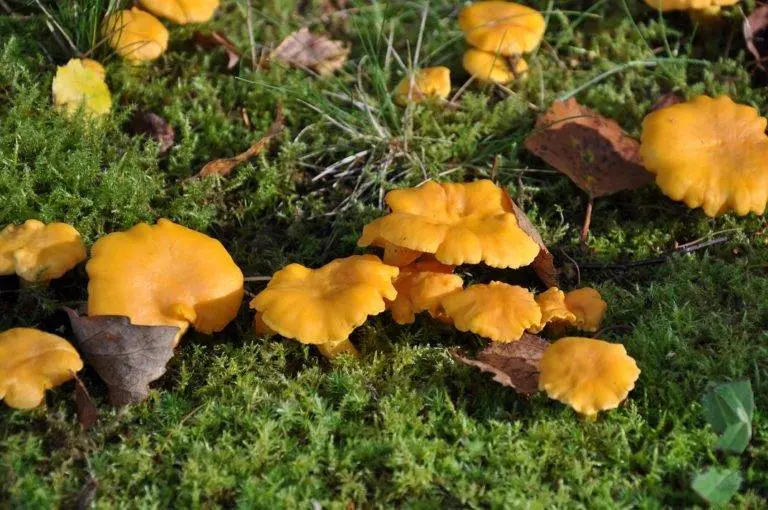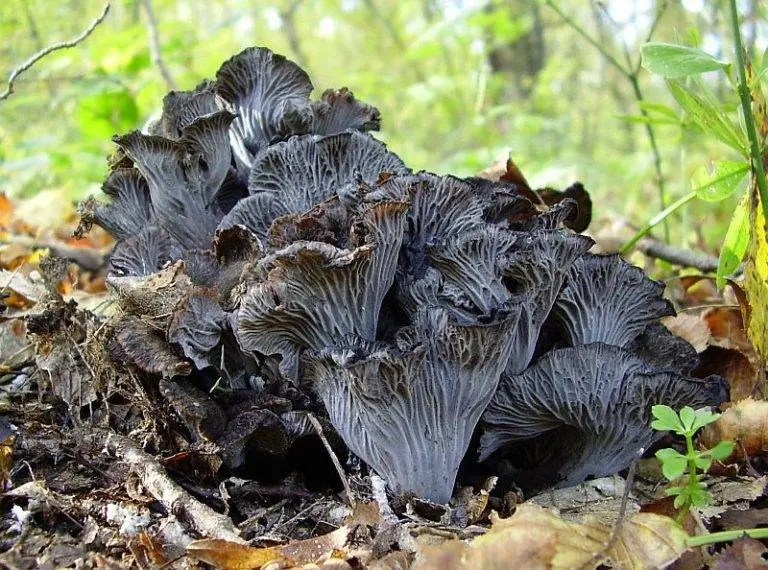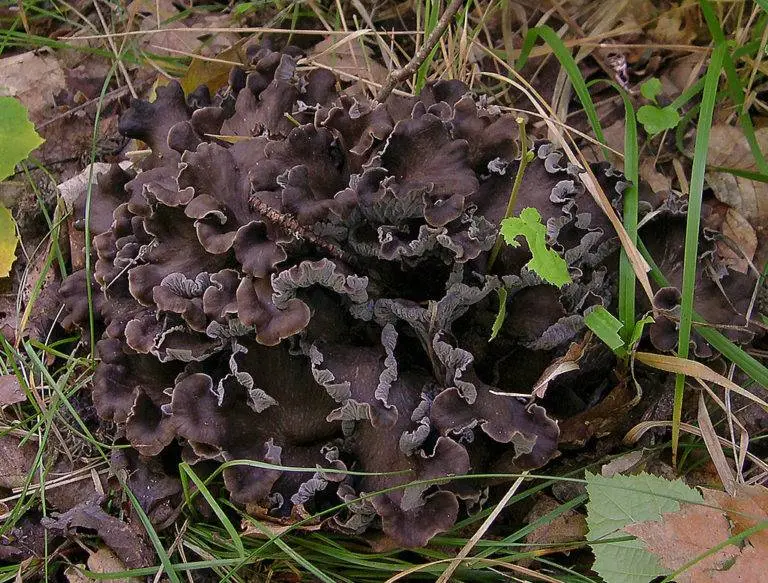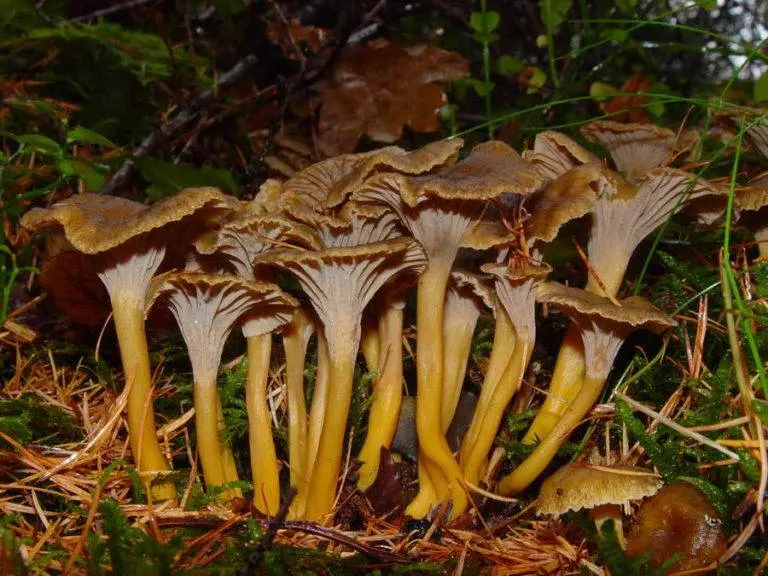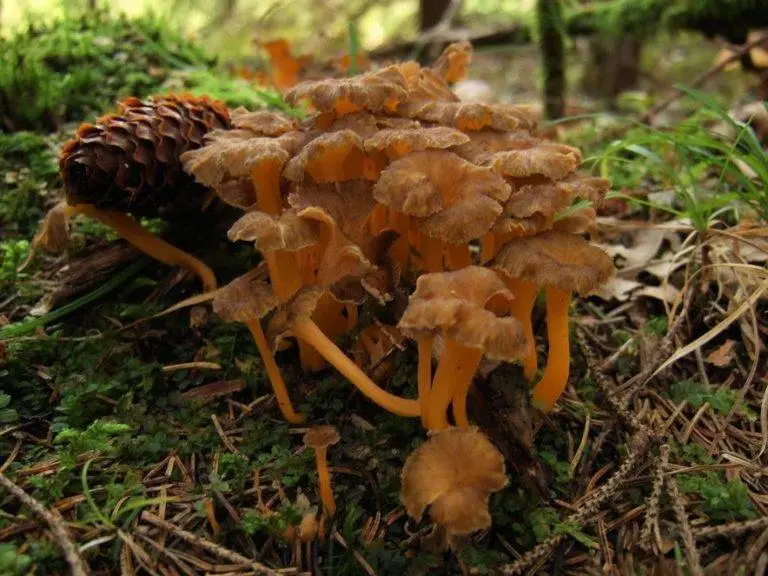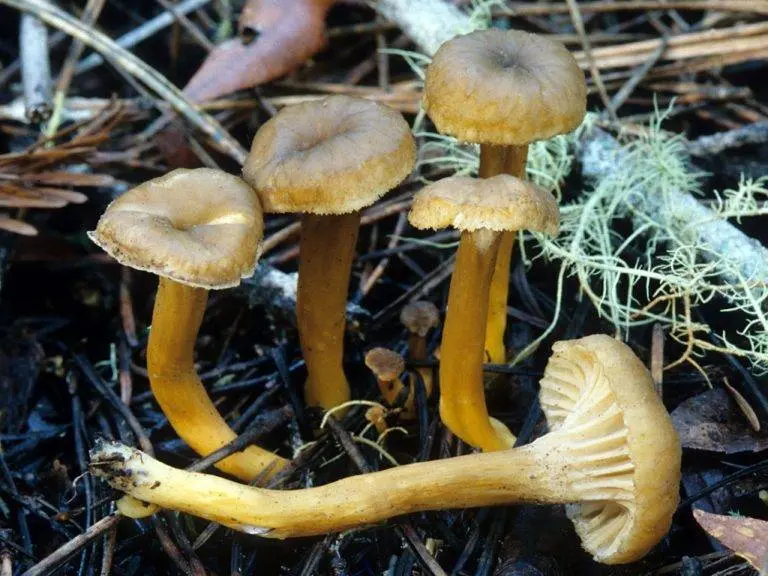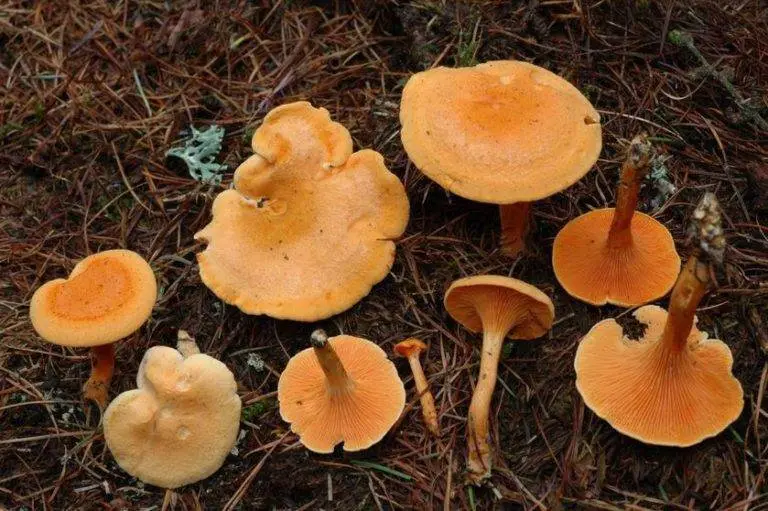Contents
- Description
- Mushroom appearance
- Where, when and in what forests do chanterelles grow?
- Chanterelle species, names, descriptions and photos
- Common chanterelle (real chanterelle, cockerel) (lat.Cantharellus cibarius)
- Gray chanterelle (lat.Cantharellus cinereus)
- Cinnabar-red chanterelle (lat.Cantharellus cinnabarinus)
- Velvety chanterelle (Latin Cantharellus friesii)
- Faceted chanterelle (lat.Cantharellus lateritius)
- Chanterelle yellowing (lat.Cantharellus lutescens)
- Tubular chanterelle (funnel chanterelle, tubular cantarell, tubular lobe) (lat.Cantharellus tubaeformis)
- Chanterelle Cantharellus minor
- Chanterelle Cantharellus subalbidus
- There are 2 types of mushrooms with which the common chanterelle can be confused:
- Useful properties of chanterelles, vitamins and minerals
- Caloric content of chanterelles
- How and how long can you store fresh chanterelles?
- How to clean chanterelles?
- Why are chanterelles bitter and how to remove bitterness?
- How to cook and store chanterelles. Cooking methods
- How to freeze chanterelles for the winter?
- 7 Interesting facts about chanterelles
- Harm and contraindications
- Also watch the vide of chanterelles hunting and cooking:
Description
Chanterelles. These mushrooms are difficult to confuse with others, as they have an extremely memorable appearance. (lat.Cantharellus) are mushrooms that belong to the Basidiomycete department, Agaricomycete class, Cantarella order, Chanterelle family, Chanterelle genus.
The body of chanterelles in shape looks like the body of cap-pedunculate mushrooms, however, the cap and the leg of chanterelles are one whole, without visible boundaries, even the color is about the same: from pale yellow to orange.
Mushroom appearance
Hat
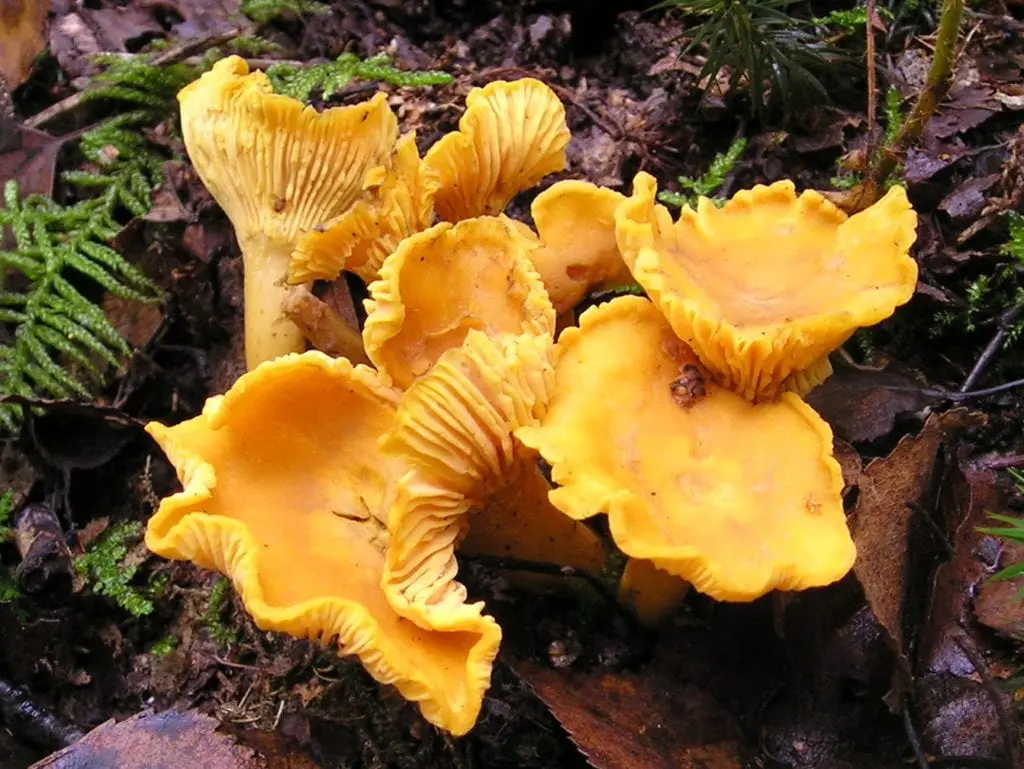
The cap of the chanterelle mushroom is from 5 and up to 12 centimeters in diameter, irregularly shaped, flat, with curled, open wavy edges, concave or depressed inward, in some mature individuals it is funnel-shaped. People call such a hat “in the shape of an inverted umbrella.” The chanterelle cap is smooth to the touch, with a hard-to-peel skin.
Pulp
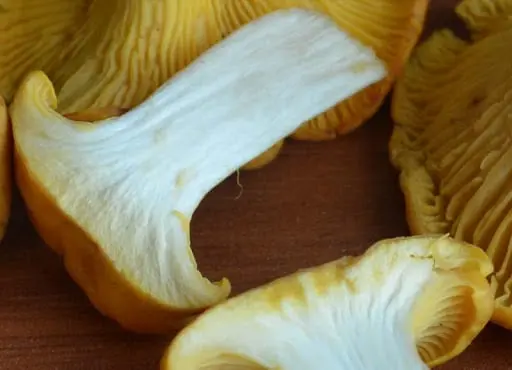
The flesh of chanterelles is fleshy and dense, fibrous in the area of the leg, white or yellowish, has a sour taste and a weak smell of dried fruit. When pressed, the surface of the mushroom turns reddish.
Leg
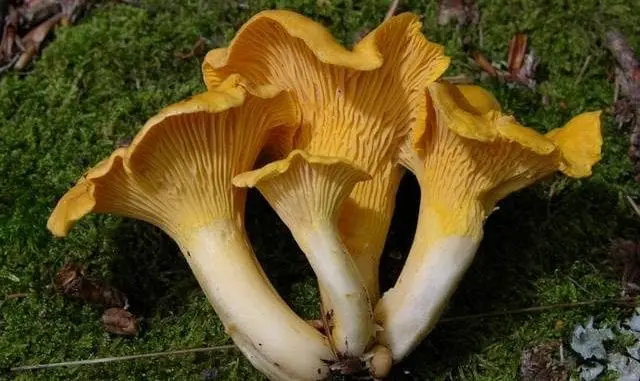
The leg of the chanterelle is most often the same color as the surface of the cap, sometimes somewhat lighter, has a dense, smooth structure, homogeneous in shape, slightly narrowed to the bottom, 1-3 centimeters thick, 4-7 centimeters long.
The surface of the hymenophore is folded, pseudoplastic. It is represented by wavy folds falling along the leg. In some species of chanterelles, it can be veined. The spore powder has a yellow color, the spores themselves are ellipsoidal, 8×5 microns in size.
Where, when and in what forests do chanterelles grow?
Chanterelles grow from early June to mid-October, mainly in coniferous or mixed forests, near spruce, pine or oak trees. They are found more often in damp areas, in temperate forests among grass, in moss or in a heap of fallen leaves. Chanterelles often grow in numerous groups, appear en masse after thunderstorms.
Chanterelle species, names, descriptions and photos
There are over 60 species of chanterelles, many of which are edible. Poisonous chanterelles do not exist, although there are inedible species in the genus, for example, the false chanterelle. Also, this mushroom has poisonous counterparts – for example, mushrooms of the genus omphalot. Below are some of the varieties of chanterelles:
Common chanterelle (real chanterelle, cockerel) (lat.Cantharellus cibarius)
An edible mushroom with a cap of 2 to 12 cm diameter. The color of the mushroom has different light shades of yellow and orange. The pulp is fleshy, yellow at the edges and white at the cut. The hymenophore is folded. The taste is slightly sour. The skin of the cap is difficult to separate from the pulp. The leg of the common chanterelle has the same color as the cap. Leg thickness 1-3 cm, leg length 4-7 cm.
Chanterelle spore powder of light yellowish color. A feature of the fungus is the absence of worms and insect larvae in it due to the content of quinomannose – a substance that is destructive to any parasites. Commonly chanterelle grows in deciduous and coniferous forests in June, and then from August to October.
Gray chanterelle (lat.Cantharellus cinereus)
Edible mushroom gray or brown-black. The hat has a diameter of 1-6 cm, a leg height of 3-8 cm, and a leg thickness of 4-15 mm. The leg is hollow inside. The cap has wavy edges and a deepening in the center, and the edges of the cap are ash gray. The pulp is firm, gray or brownish in color. The hymenophore is folded.
The taste of the mushroom is inexpressive, without aroma. The gray chanterelle grows in mixed and deciduous forests from late July to October. This mushroom can be found in the European part of Russia, Ukraine, America and Western Europe. The gray chanterelle is known to few, so mushroom pickers avoid it.
Cinnabar-red chanterelle (lat.Cantharellus cinnabarinus)

Reddish or pinkish-red edible mushroom. The diameter of the cap is 1-4 cm, the height of the leg is 2-4 cm, the flesh is fleshy with fibers. The edges of the cap are uneven, curved; the cap itself is concave towards the center. The hymenophore is folded. Thick pseudo-plates are pink.
Spore powder has pink-cream color. The cinnabar chanterelle grows in deciduous forests, mainly oak groves, in Eastern & North America. The mushroom picking season is summer and autumn.
Velvety chanterelle (Latin Cantharellus friesii)
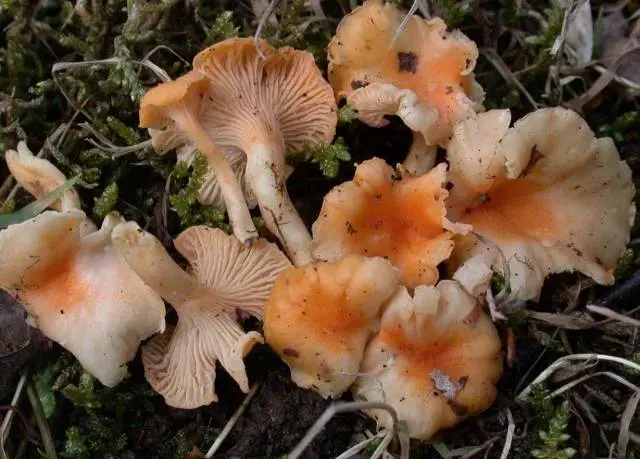
An edible but rare mushroom with an orange-yellow or reddish head. The color of the leg is from light yellow to light orange. The diameter of the cap is 4-5 cm, the height of the leg is 2-4 cm, the diameter of the stem is 1 cm. The cap of a young mushroom has a convex shape, which turns into a funnel-shaped one with age.
The flesh of the cap is light orange when cut, whitish-yellowish at the stem. The smell of the mushroom is pleasant, the taste is sour. The velvety chanterelle grows in the countries of southern and eastern Europe, in deciduous forests on acidic soils. The harvesting season is from July to October.
Faceted chanterelle (lat.Cantharellus lateritius)
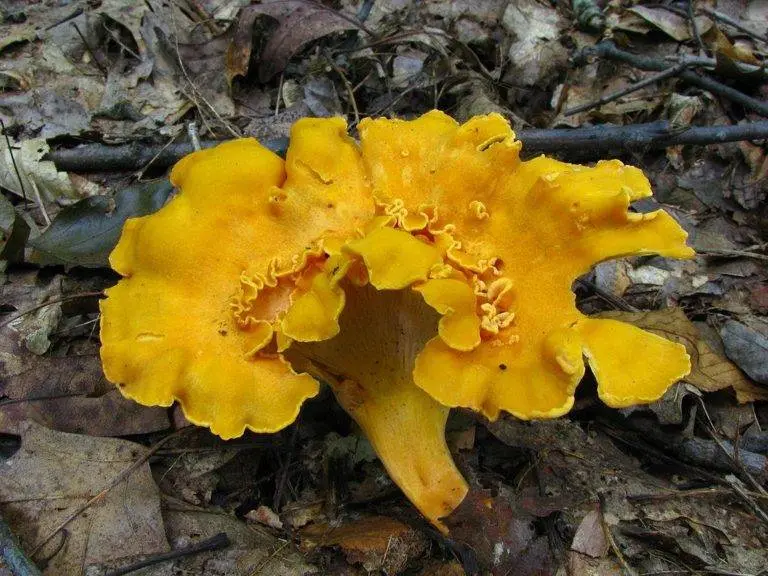
Orange-yellow edible mushroom. The edible body measures from 2 to 10 cm. The cap and stem are combined. The shape of the cap is carved with a wavy edge. The pulp of the mushroom is thick and dense, has a pleasant taste and aroma. Leg diameter 1-2.5 cm.
The hymenophore is smooth or with slight folds. The spore powder has a yellow-orange color, like the mushroom itself. The faceted chanterelle grows in oak groves in North America, Africa, the Himalayas, Malaysia, singly or in groups. You can pick chanterelle mushrooms in summer and autumn.
Chanterelle yellowing (lat.Cantharellus lutescens)
Edible mushroom. The diameter of the cap is from 1 to 6 cm, the length of the leg is 2-5 cm, the thickness of the leg is up to 1.5 cm. The cap and the leg are a single whole, like in other species of chanterelles. The upper part of the cap is yellow-brown in color, with brown scales. The leg is yellow-orange.
The pulp of the mushroom is beige or light orange, has no taste or smell. The spore-bearing surface is most often smooth, less often with folds, and has a beige or yellow-brown tint. Spore powder beige-orange. The yellowing chanterelle grows in coniferous forests, on moist soils, you may find until the end of summer.
Tubular chanterelle (funnel chanterelle, tubular cantarell, tubular lobe) (lat.Cantharellus tubaeformis)
An edible mushroom with a cap diameter of 2-6 cm, a leg height of 3-8 cm, a stem diameter of 0.3-0.8 cm. The chanterelle’s cap is funnel-shaped with uneven edges. The color of the cap is grayish yellow. It has dark velvety scales. The tubular stem is yellow or dull yellow.
The flesh is firm and white, with a slight bitter taste and a pleasant earthy smell. The hymenophore is yellowish or bluish-gray, consists of rare brittle veins. Spore beige powder. Tubular chanterelles grow mainly in coniferous forests, sometimes found in deciduous forests in Europe and North America.
Chanterelle Cantharellus minor
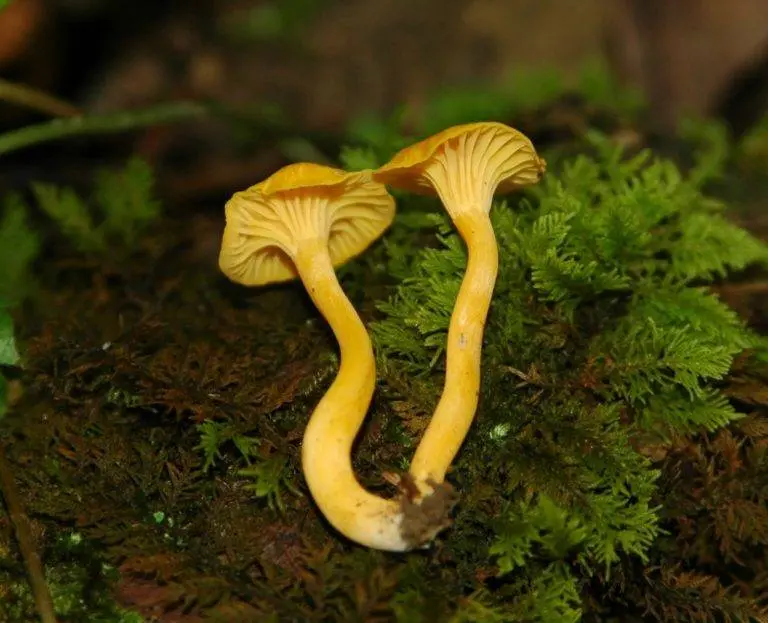
An edible mushroom, similar to the common chanterelle, but smaller in size. The diameter of the cap is 0.5-3 cm, the length of the leg is 1.5-6 cm, the thickness of the leg is 0.3-1 cm. The cap of a young mushroom is flat or convex; in a mature mushroom it becomes vase-like. The color of the cap is yellow or orange-yellow. The edge of the cap is wavy.
The pulp is yellow, brittle, soft, with a barely perceptible aroma. The hymenophore has the color of the cap. The color of the leg is lighter than that of the cap. The leg is hollow, tapering towards the base. The spore powder is white or yellowish in color. These mushrooms grow in deciduous forests (most often oak) in Eastern & North America.
Chanterelle Cantharellus subalbidus
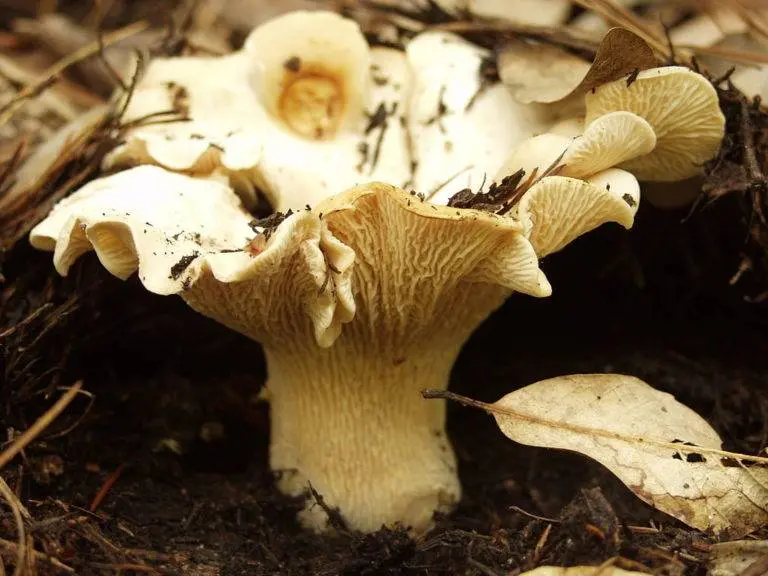
Edible mushroom, whitish or beige in color. Turns orange when touched. The wet mushroom takes on a light brown tint. The diameter of the cap is 5-14 cm, the height of the leg is 2-4 cm, the thickness of the leg is 1-3 cm. The cap of a young mushroom is flat with a wavy edge, with the growth of the fungus it becomes funnel-shaped.
There are velvet scales on the skin of the cap. The pulp of the mushroom has no aroma or taste. The hymenophore has narrow folds. The leg is fleshy, white, uneven or smooth. Spore powder is white. The chanterelle mushroom Cantharellus subalbidus grows in the northwestern part of North America and is found in coniferous forests.
There are 2 types of mushrooms with which the common chanterelle can be confused:
- Orange talker (inedible mushroom)
- Omphalot olive (poisonous mushroom)
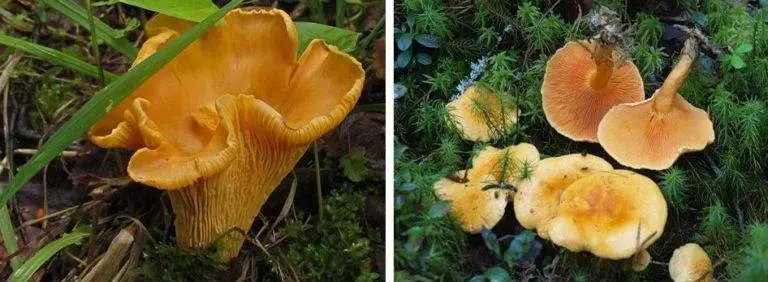
The main differences between edible chanterelles and false ones:
- The color of the common edible chanterelle is monochromatic: light yellow or light orange. The false chanterelle usually has a brighter or lighter color: copper-red, bright orange, yellowish-white, ocher-beige, red-brown. The middle of the cap of a false chanterelle may differ in color from the edges of the cap. On the head of a false chanterelle, spots of various shapes can be observed.
- The edges of the cap of a real chanterelle are always torn. The false mushroom often has straight edges.
- The leg of a real chanterelle is thick, the leg of a false chanterelle is thin. In addition, in an edible chanterelle, the cap and leg are a single whole. And in a false chanterelle, the leg is separated from the cap.
- Edible chanterelles almost always grow in groups. The false chanterelle can grow singly.
- The smell of an edible mushroom is pleasant as opposed to an inedible one.
- When pressed, the flesh of the edible chanterelle turns red, the color of the false chanterelle does not change.
- Real chanterelles are not wormy, which cannot be said about their poisonous counterparts.
Useful properties of chanterelles, vitamins and minerals
- Chanterelles contain a large amount of vitamins and minerals: D2 (ergocalciferol), A, B1, PP, copper, zinc.
- Edible chanterelle mushrooms are distinguished by the fact that they are practically never wormy. This is due to the presence of chinomannose (chitinmannose) in the chanterelle pulp, which is a poison for helminths and arthropods: it envelops the eggs of parasites, completely destroying them. Thus, these ginger mushrooms are an excellent remedy for worms and other parasites.
- Ergosterol, which is contained in the ginger mushroom, is useful for liver diseases, hepatitis and hemangiomas.
- Chanterelles are useful for vision, in the fight against cancer, obesity, in the fight against bacteria. These mushrooms are natural antibiotics and are very actively used in fungotherapy and folk medicine.
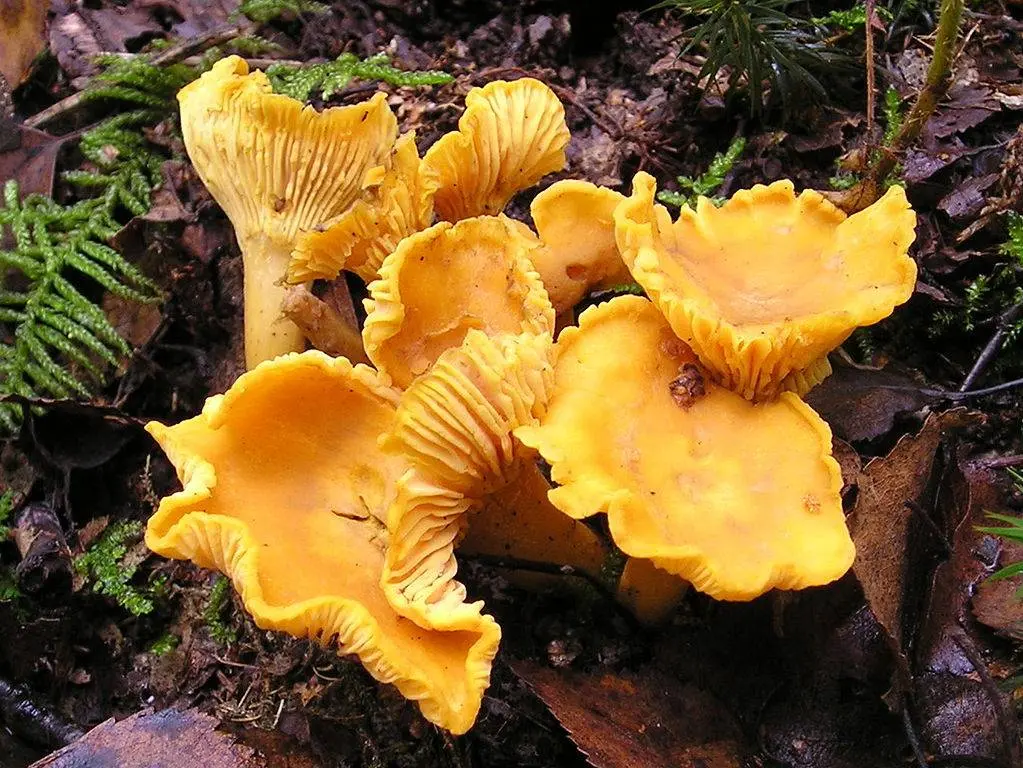
Caloric content of chanterelles
The calorie content of chanterelles per 100 g is 19 kcal.
How and how long can you store fresh chanterelles?
Store mushrooms at a temperature of no more than + 10 ° C. Freshly collected chanterelles cannot be kept for more than a day, even in the refrigerator. It is best to start processing them right away.
How to clean chanterelles?
The mushrooms must be cleaned of debris and the damaged mushrooms must be separated from the whole ones. Forest debris is removed with a hard brush or soft cloth (sponge). The dirt does not adhere to the surface of the chanterelles so much that it needs to be cleaned off with a knife. The rotten, softened and damaged parts of the mushroom are cut with a knife. Litter is removed from the plates with a brush. This is especially important for subsequent drying.
After cleaning, the chanterelles need to be rinsed well, paying special attention to the under-hat plates. They are usually washed in several waters. If you suspect a bitter taste, the mushrooms are soaked for 30-60 minutes.
Why are chanterelles bitter and how to remove bitterness?
Chanterelles have a natural bitterness, for which they are especially appreciated in cooking and for which they are not liked by various insects and pests. The bitterness increases if the mushrooms are not processed immediately after harvest, as well as under the influence of the following natural factors.
Chanterelles collected can have a bitter taste:
- in hot dry weather;
- under coniferous trees;
- in moss;
- close to busy highways and ecologically dirty industrial plants;
- overgrown mushrooms;
- false chanterelles.
- It is best to harvest and cook young mushrooms with unopened caps. The likelihood of bitterness in them will be low.
To prevent the chanterelles from becoming bitter, they can be soaked for 30-60 minutes, and then boiled, draining the water after cooking. By the way, you can boil not only in water, but also in milk.
It is better to freeze boiled mushrooms: firstly, it turns out more compactly, and secondly, in boiled form they will not taste bitter. If you have frozen fresh chanterelles, and after defrosting found that they are bitter, try the following:
Boil mushrooms in boiling salted water. You can add a couple pinches of citric acid. The bitterness will transfer to the water, which you then drain.
How to cook and store chanterelles. Cooking methods

boil
Cut large chanterelles into slices and cook after boiling over reduced heat for 15-20 minutes. You can boil not only in enameled dishes, but also in a multicooker or microwave oven. If you eat mushrooms right after cooking, then you need to salt the water. In this case, the broth can be used to prepare various dishes. If, after boiling, you fry the chanterelles, then it is wiser to leave the water unsalted so that mineral salts do not come out of the mushrooms. In this case, you don’t need to cook them for more than 4-5 minutes. First rinse the dried chanterelles several times in warm water, and then soak in cold water for 2-4 hours. Then put them to boil in the same water. Let them simmer for 40-60 minutes.
fry
It is not necessary to boil the chanterelles before frying. But if you want the mushrooms not to taste bitter, it is better to boil them, draining the water after cooking.
Before frying, the mushrooms need to be cut: the cap into equal slices, the leg – into circles. Since mushrooms contain 90% water, and at a temperature of 60-70 °, the liquid leaves the fruit bodies, they begin to fry only after the evaporation of this juice. Fry finely chopped onions in a frying pan in oil, then add the chanterelles and fry until the moisture that has been released evaporates. Then salt, add sour cream if desired and simmer until cooked for 15-20 minutes. Chanterelles can also be baked and simmered.
salt
Different sources treat chanterelle salting differently. Some say that these forest dwellers are good in any form except salted ones. Others give different salting recipes and argue that salted chanterelles have a right to exist. They say that chanterelles prepared in this way are somewhat harsh and inexpressive in taste.
Chanterelles are salted cold and hot. For cold salting, mushrooms are washed and soaked for a day in water with salt and citric acid (per liter of water: 1 tablespoon of salt and 2 grams of citric acid). You do not need to boil them. The chanterelles, dried after soaking, are laid out in prepared dishes: enameled, wooden or glass.
First, the bottom of the container is sprinkled with salt, then the mushrooms are laid out with their heads down in layers of 6 cm, sprinkling each of them with salt (50 g of salt per kilogram of chanterelles), dill, chopped garlic, currant leaves, horseradish, cherries, caraway seeds. From above, the mushrooms are covered with a light cloth, the dishes are closed with a lid that fits freely into it and pressed down with oppression. Keep warm for 1-2 days for fermentation, then put out in the cold. You can eat chanterelles after 1.5 months from the moment of salting.
marinate
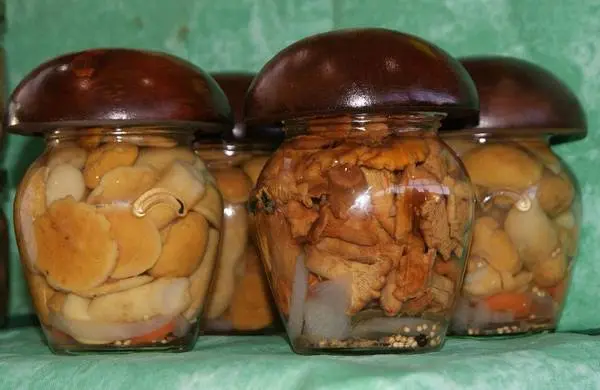
Pickled chanterelles with subsequent pasteurization. Before harvesting, the fruiting bodies of common chanterelles must be thoroughly cleaned and rinsed. Cut large mushrooms into 4 pieces, small ones leave intact. They are boiled in salt water with citric acid for 15 minutes. Hot chanterelles are laid out in prepared jars and poured with marinade so that 2 cm remains to the edge of the jar.
On top you can add onion rings, laurel leaves, pieces of horseradish root. Covered jars are pasteurized for 2 minutes – this is the optimal time for preserving B vitamins in mushrooms. Pickled chanterelles should be stored at temperatures from 0 to 15 ° in a dry cellar.
Pickled chanterelles without pasteurization. First, the mushrooms are boiled in salt water for about 15 minutes. Then the marinade is prepared – water is boiled with the addition of salt and vinegar. Mushrooms are placed in a boiling marinade and boiled for 20 minutes. Spices and sugar are added 3 minutes before the end of cooking. Chanterelles are laid out in sterilized jars, poured with marinade in which they were cooked, and rolled up.
ferment
The washed chanterelles are cut into equal slices. Water is poured into a saucepan, 1 tablespoon of salt, 3 g of citric acid are put there (per 1 kg of chanterelles). Bring to a boil and then add mushrooms, cook for 20 minutes. At the same time, they are stirred and the resulting foam is removed. Then the mushrooms are thrown into a colander, washed with cold water and dried.
Bring the filling to a boil, but do not boil: 5 tablespoons of salt and 2 tablespoons of sugar are taken per liter of water. Cool the solution to 40 ° C. Add skim sour milk whey (20 g per 1 liter of solution). Three-liter jars are filled with mushrooms, filled with prepared liquid. They keep it warm for three days, and then take it out into the cold.
dry
Healthy, unwashed, but well-peeled mushrooms are cut into slices 3-5 mm thick along the fruiting body. The chopped chanterelles are placed on a drying board or in a special dryer so that they do not come into contact with each other.
Chanterelles can be dried in rooms that are well ventilated, outdoors (in the shade or in the sun), in a dryer, in an oven, in an oven.
First, the mushrooms are dried at a low temperature (60-65 °) so that juice does not flow out of them, and then at a higher temperature. When drying mushrooms in the sun, it is important to ensure that they are not exposed to dew and rain. Chanterelles are considered well-dried if the mushroom slices are finely crumbled between the toes. Dried chanterelles are stored in tin, glass or plastic containers with tight-fitting lids.
How to freeze chanterelles for the winter?
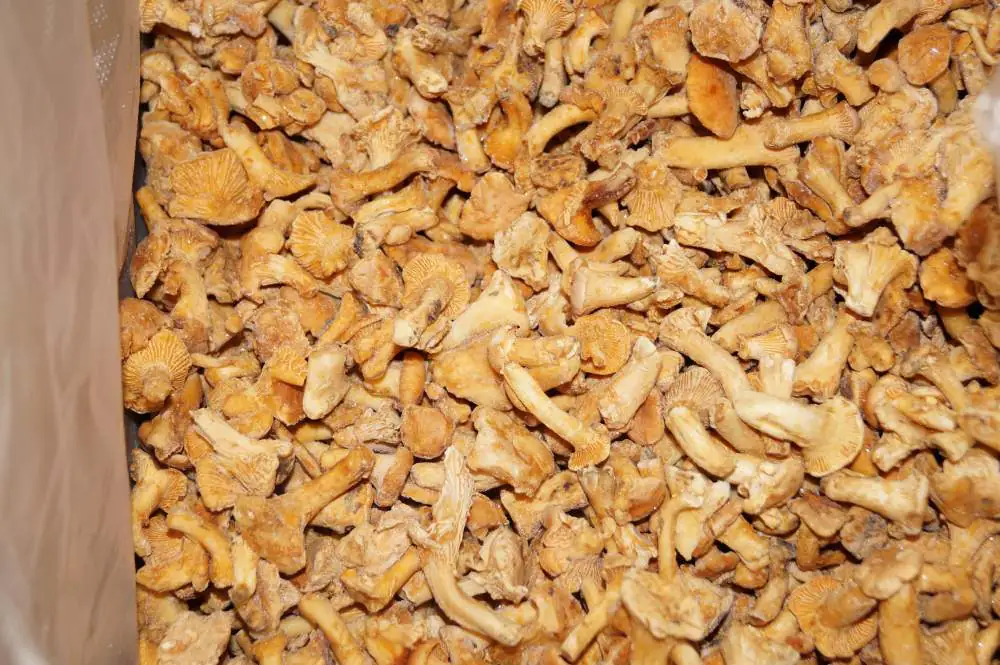
Before freezing, the mushrooms must be thoroughly washed and dried well by placing them on a cloth. You can freeze fresh, boiled, baked and fried chanterelles. Fresh (raw) mushrooms can taste bitter after thawing. Therefore, before freezing, it is better to boil them in water or milk, fry them in oil or bake them in the oven.
Prepared and dried mushrooms can be folded into freezer bags, food containers made of polymers, metal or glass, in the latter case, filling the containers by 90%. Close tightly so that food does not come into contact with air. Store in a freezer at -18 ° C for one year.
Defrost mushrooms on the bottom shelf of the refrigerator at a temperature of + 4 ° C. For defrosting, do not heat them or pour boiling water over them. In addition, thawed mushrooms must not be re-frozen. If they are accidentally thawed due to a breakdown of the refrigerator, and you want to freeze them again, then this can be done by first boiling or frying the mushrooms.
7 Interesting facts about chanterelles
- The chinomannose contained in chanterelles helps to cope with the helminths that have infected humans. However, this polysaccharide is destroyed during heat treatment already at 50 ° C, and salt kills it when salted. Therefore, herbalists advise using alcoholic infusion of chanterelles for treatment.
- The pharmacy sells the drug “Fungo-Shi – chanterelles”, intended for the treatment of helminthiasis.
- The antibiotic contained in chanterelles blocks the development of tubercle bacillus.
- Chanterelles often grow in the form of “witch rings”. In ancient times, European peoples mystified such phenomena. They attributed the appearance of the rings to the covens of witches, the tricks of the elves. Now scientists explain this by the fact that a spore that has fallen to the ground forms a mycelium, which grows evenly in all directions, forming an even circle. And the middle part of the mycelium gradually dies off.
- Although there are vitamins in mushrooms, they are completely destroyed during cooking. The exception is mushrooms rich in vitamin C in fermented form.
- If a pine or birch grows near the house, then you can try to grow your chanterelles under them. Knead the mushroom caps, put them, without burying, on the surface of the soil near the tree, water and mulch on top with pine needles or birch leaves.
- Chanterelles contain the highest amount of fat in comparison with other mushrooms – 2.4%. Fats in mushrooms are concentrated mainly in the spore-bearing layer, in chanterelles – in the plates.
Harm and contraindications
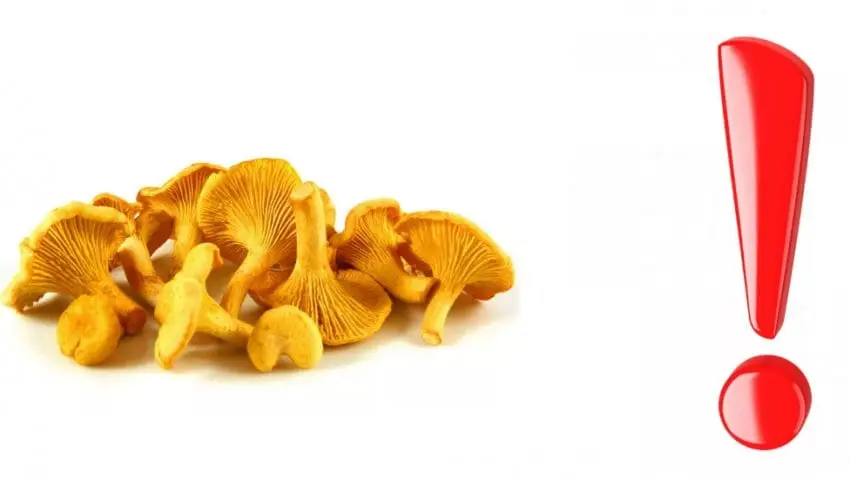
There are not so many cases when the use of chanterelles must be completely abandoned, and, as a rule, such restrictions apply to any forest mushrooms. In particular, direct contraindications to the use of the product are:
- pregnancy;
- children’s age (up to 3 years old);
- individual intolerance (allergic reaction) to any of the substances that make up the fungus;
- acute gastrointestinal diseases – gastritis, pancreatitis, ulcers, colitis, etc. (in this state, coarse fiber is too heavy food, and the patient’s menu should be selected with great care and mainly consist only of semi-liquid viscous cereals).
People who have problems with the gallbladder need to be wary of forest mushrooms. Nutritionists also do not recommend eating such food at night. A controversial issue is the compatibility of mushrooms with the period of breastfeeding.
Modern medicine comes to the conclusion that the nutrition of a nursing mother contains much fewer restrictions than previously thought. Therefore, in general, most likely, if a woman eats a few chanterelles (even fried ones) during lactation, there will be no harm from this to the child.
But only if the mushrooms are fresh, of high quality and proven. If you have any doubts about any of the above parameters, it is better not to take a risk. In general, the main danger of chanterelles is precisely that not everyone knows how to recognize them correctly.











